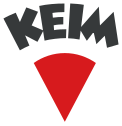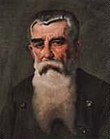Germ colors
| Keimfarben GmbH
|
|
|---|---|
| legal form | GmbH |
| founding | 1878 |
| Seat | Diedorf , Germany |
| management | Managing director authorized to represent: Rüdiger Lugert |
| Number of employees | approx. 500 worldwide |
| Branch | Building materials industry |
| Website | www.keim.com |
The Keimfarben GmbH (proper spelling in capital letters ) is a medium-sized company based in Diedorf in Augsburg . It belongs to the Leonhard Moll AG group of companies and is the world's leading manufacturer of silicate paints . Buildings like the White House , Buckingham Palace , the Sydney Opera House , the Bolshoi Theater and the Kremlin are painted with germinative colors.
Company founder Adolf Wilhelm Keim is considered to be the inventor of the silicate paints (mineral paints), which revolutionized the building and painting trade at the end of the 19th century.
history
During the reign of King Ludwig I of Bavaria , intensive research into the water glass began . The monarch was enthusiastic about the colorful lime frescoes of northern Italy and wanted to be able to enjoy this splendor of colors typical of lime colors in his native Bavaria as well. The harsh German weather, however, was not suitable for the technology used in Italy.
The craftsman and researcher Adolf Wilhelm Keim finally succeeded in using the appropriate mixture of liquid water glass (potassium silicate) and mineral color pigments to create a color that was able to cope with the demands of the climate north of the Alps and at the same time had a brilliant color. The reason for the durability of the color lies in the chemical bond between the binder and the substrate ( silicification ). In 1878 Keim had its mineral paints patented and thus laid the foundation for today's Keimfarben GmbH. The first production facility was located near the limestone quarry in Offenstetten (now part of Abensberg ) in Lower Bavaria .

After the First World War, the company was relocated to Neusäß near Augsburg and was renamed Industriewerke Lohwald AG on January 20, 1919 . The field name Lohwald was part of the municipality of Neusäß. From 1920 to 1950 the number of employees was continuously between 20 and 30. From the beginning of the 1960s the workforce rose to 60 people. In 1966 the name was changed to Industriewerke Lohwald Keimfarben GmbH & Co. KG , later to Keimfarben GmbH & Co. KG .
Due to successful expansions, an expansion of the production and administration facilities became necessary from the mid-1980s, but this was no longer possible in Lohwald under building law . Against this background, the company relocated its headquarters and production to Diedorf in 1989 . The company premises in Lohwald were acquired by the city of Neusäß in 1992, which built a nursing home and apartments for the elderly on it. In addition to the street name Keimstraße, a building ensemble from the Lohwalder company location that is now a listed building , the gatehouse, has been preserved .
Group structure
Keimfarben has two German locations in Diedorf (headquarters) and Alteno / Luckau and is active with a total of eleven foreign subsidiaries in Europe (Austria, Switzerland, Italy, France, Spain, the Netherlands, Great Britain, Scandinavia, Poland, the Czech Republic) and the United States. In the countries in which Keimfarben is not represented with its own subsidiary, authorized dealers take over sales (in Australia, Canada, China, Singapore, Malaysia and Russia). Keimfarben GmbH & Co. KG changed its legal form on September 6, 2012 and has been operating under the name Keimfarben GmbH since then .
Product range
Keim laid the foundation for the success of Keimfarben in 1878 with KEIM Purkristalat, a two-component pure silicate paint . The second generation of Keim paints followed in 1962 with Keim Granital, the first dispersion silicate paint, which, in contrast to Purkristalat, is one-component and therefore easier to process. In 2002, Keimfarben launched Keim Soldalit, a sol-silicate paint or silica sol-silicate paint ( silica sol binder and water glass ) that makes the use of silicate paints even more universal and easier.
Keimfarben produces paint systems for outdoor and indoor areas, mineral plasters and fillers , natural stone repair systems , thermal insulation composite systems as well as concrete repair and surface protection. A new addition to the product range under the name Lignosil ® is a silicate paint for wooden surfaces.
swell
- Marion Wohlleben, Brigitt Sigel (Red.): Mineral paints: Contributions to the history and restoration of facade paintings and paints. Festschrift for the 120th anniversary of the Keimfarben company . (Institute for Monument Preservation, 19) Zurich: vdf Hochschul-Verl. AG at the ETH, 1998, ISBN 3-7281-2651-9
- Kurt Schönburg: Coating Techniques Today Huss Medien GmbH, Berlin, 2005, ISBN 3-345-00831-9 (p. 149 ff)
- Kurt Schönburg: Historical coating techniques building industry, Berlin, 2002, ISBN 3-345-00796-7 (p. 191 ff)
Web links
- Rundschau: Bavaria's colors around the world Company portrait Keimfarben; Bavarian TV 2015
- Detlef Esslinger : The world in color , in: SZ-Magazin issue 39/2015, pp. 46–52.
- color-europe: A brief history of silicate paint technology ( Memento from October 8, 2008 in the Internet Archive ); Publishing phenomenon color
- Evening show: Report from Diedorf, part 1 Keimfarben company portrait; Bavarian television, March 2016
- Evening show: report from Diedorf, part 2 company portrait Keimfarben; Bavarian television, March 2016
Individual evidence
- ↑ Florian Langenscheidt , Bernd Venohr (Hrsg.): Lexicon of German world market leaders. The premier class of German companies in words and pictures . German Standards Editions, Cologne 2010, ISBN 978-3-86936-221-2 , pp. 332f.
- ↑ a b Die Welt in Farbe ( German ) Retrieved on October 9, 2015.
- ↑ Stern 20, 2009, p. 94
- ↑ Keimfarben Insoluble Connection ( German ) Retrieved on May 16, 2009.
- ^ Marion Wohlleben: Mineral colors. Contributions to the history and restoration of facade paintings and paintings. VDF Hochschulverlag AG, 1998, p. 36. f.
- ^ City of Neusäß (ed.): Heimatstimme. Official and newsletter of the city of Neusäß. 52. Vol. 10. Mayor's and Cultural Office of the City of Neusäß, 2007, p. 17.



